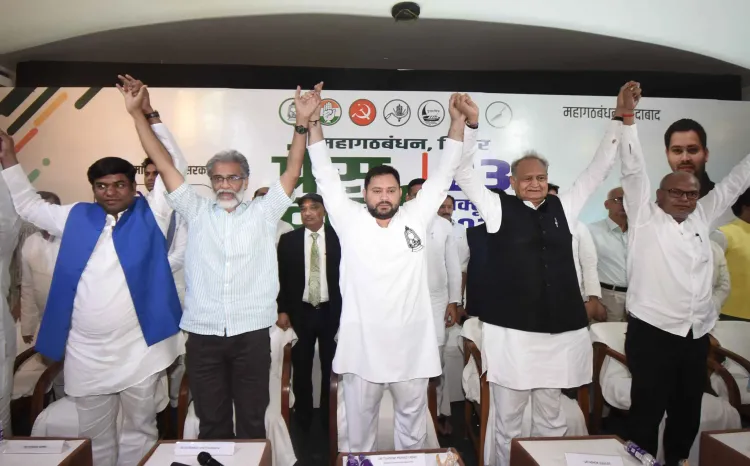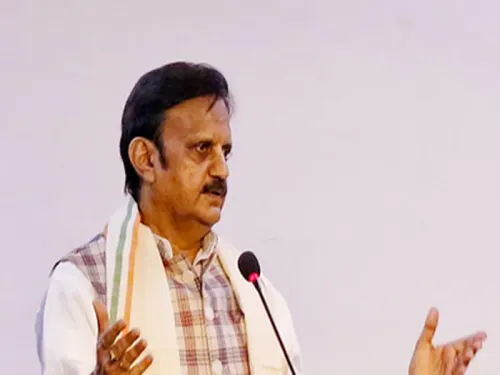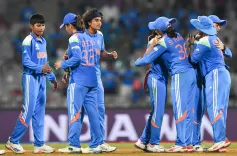Is Bihar's Opposition Reflecting Reconciliation Where Political Interests Prevail?

Synopsis
Key Takeaways
- Tejashwi Yadav's endorsement is driven by political necessity.
- Historical rivalries are being set aside for electoral strategy.
- The Mahagathbandhan includes major parties like the RJD, Congress, and the Left.
- The alliance aims to counter the BJP's growing influence.
- Political dynamics in Bihar are rapidly evolving.
New Delhi, Oct 23 (NationPress) The endorsement of Tejashwi Yadav as the Chief Ministerial candidate of the Mahagathbandhan by his allies stems more from political necessity and electoral strategy than from genuine camaraderie.
The core members of this alliance – the Rashtriya Janata Dal (RJD), Congress, and the Left parties – have historically been adversaries in Bihar, often undermining each other’s support bases.
Previously, the Left factions were not unified, with the Communist Party of India (CPI) and the Communist Party of India (Marxist) (CPI(M)) being part of the Left Front, alongside smaller parties. The Indian People’s Front (IPF) and the Marxist Coordination Committee (MCC) represented the political factions associated with the Maoists or ultra-Left.
However, the Dipankar Bhattacharya-led Communist Party of India (Marxist Leninist) Liberation differs from the banned group of a similar name and actively participates in elections, unlike the Maoist insurgents.
Although Bhattacharya's party is part of the Mahagathbandhan in Bihar, it is not included in the Left Front elsewhere. The RJD, the principal party within the Mahagathbandhan, was founded by Lalu Prasad Yadav, who first entered the Lok Sabha in 1977 as part of the Janata alliance.
Lalu Prasad was a prominent figure in the Jaiprakash Narain movement and was involved in the anti-Emergency protests, even spending time in jail during this tumultuous period. He successfully ousted the Congress in 1990, positioning himself as a champion for the masses, advocating for populist redistribution and identity politics.
During this time, he capitalized on the Union government's decision to implement the Mandal Commission recommendations regarding reservations for Other Backward Classes (OBCs). He rallied for social justice for backward classes and minorities, gaining prominence through a vigorous, caste-focused mobilization that challenged the Congress's dominance in Bihar.
His mobilization efforts also began to diminish the support base of the Communists, who had substantial backing among the disadvantaged and backward classes. Lalu garnered support from Yadavs, OBCs, and Muslims, who collectively represent about 14%, 27%, and 17% of Bihar's electorate, respectively.
In the 1990 elections for undivided Bihar's 324 Assembly seats, the RJD secured 122 seats, while the Left parties managed to win 23 for CPI, 6 for CPI(M), 7 for IPF, and 2 for MCC. The Congress experienced a significant drop, winning only 71 seats compared to its previous tally of 125.
Over time, the influence of the Left and Congress in Bihar has diminished. However, the Mahagathbandhan has rekindled hopes for revival, with the RJD emerging as the leading party with 75 seats and the Left securing 16. This shift reflects the practical electoral landscape and changing political dynamics that compelled Lalu to set aside historical rivalries for tactical alliances when beneficial.
The ascent of the Bharatiya Janata Party (BJP) as a formidable national force, particularly due to its electoral successes in Bihar and strategic partnerships, necessitated a realignment for Lalu.
Previously, the RJD supported the Congress at the national level through coalition-building, parliamentary backing, and electoral mobilization, which bolstered the United Progressive Alliance (UPA) in terms of legitimacy and vote calculations.
From 2004 onward, Lalu formally aligned with the Congress-led UPA, providing support and accepting ministerial positions, with Lalu serving as the Union Railway Minister. This alliance helped the coalition achieve the necessary numbers in Parliament and established a visible regional partner in Bihar.
Through this coalition, the RJD succeeded in garnering policy attention for Bihar and secured various concessions and transfers of central schemes, among other goals.
Beyond electoral support, Lalu’s involvement symbolized a broader secular-opposition front, enabling the Congress to frame the national contest as a contest between the centre and the BJP, thereby attracting other regional parties to collaborate and strengthen the anti-BJP narrative nationally.
Since then, from the INDIA Bloc at the Centre to the Mahagathbandhan in Bihar, the opposition to the BJP and the necessity for a broad secular front have overshadowed former rivalries, showcasing political reconciliations ahead of recent elections.









